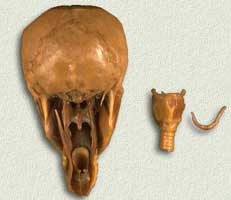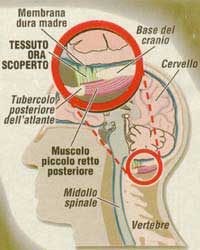Anatomical Correlations Between Dental Occlusion and Posture
Dr. Piero Silvestrini Biavati
Anatomical correlations between dental occlusion and posture
Dr. Piero Silvestrini Biavati - MD, Dentist, PhD Genoa
Posturology is a relatively new branch of medicine. The newest concept is the holistic view of many small pathologies that can create symptoms or damage in districts distant from the cause. The synergy among professionals from very different specialties is the conditio sine qua non for a correct approach to the patient to be treated. Those working in the rehabilitation sector, broadly speaking, have often noticed that targeted interventions in a small body district result in symptomatic improvements in apparently unrelated sectors. This applies to physiotherapists, dentists, ENT specialists, opticians, podiatrists, osteopaths, etc. Note, I am talking about small pathologies and symptoms that, combined, cause great discomfort, but certainly not serious anatomical or pathological alterations. Here, precisely, the figure of the posturologist comes into play to discriminate with appropriate tests and differential diagnoses which cases to treat and which to refer to specialists in other sectors.
One of the fathers, in my opinion, of posturology is Dr. Costen, an otolaryngologist, who in 1934 laid the foundations for a syndrome named after him, which associates vertiginous problems, hypoacusis, and temporomandibular joint problems. On the website www.otoneuro.it these correlations are wonderfully explained, I quote a part:
The symptoms identified by Costen were in order: variable hypoacusis over time, "fullness" especially postprandial, mild low-frequency tinnitus and rarely clicking on chewing, mild instability or severe vertiginous crises resolved after tubal insufflations, severe and constant headache especially occipital and serotinal, burning oropharyngodynia.
To justify the otologic symptoms, Costen imagined a mechanical etiopathogenesis and more precisely attributed the cause of hypoacusis, fullness, and even vertigo to tubal insufficiency secondary to malocclusion.
The real culprit was the superior head of the lateral pterygoid muscle which, in case of marked "overbite," could relax favoring the crushing of the tube.
Furthermore, the tensor veli palatini, also loosened by the abnormal position of the mandible, would have lost some of its efficiency in opening the tube itself.
Finally, capsuloligamentous laxity would have caused further compression of tissues against the tube.
To justify the pain symptom, Costen thought of three neurogenic mechanisms.
The first is caused by glenoid bone erosion exposing the rich dural algogenic nerve plexus of the basicranium. The second is determined by compression of the auriculotemporal nerve by a hypermobile condyle. Finally, the third is due to involvement of the chorda tympani.
As can be seen, even though the body districts are contiguous, pathologies of completely different specialist sectors sum up, the dentist, the neurologist, the vestibulologist, the otologist.
Among all the existing scientifically proven or daily observable correlations, in my opinion some are truly significant.
fig.1 Peristaphilinus muscle

Rectus capitis posterior minor muscle.
In 1995, three neurologists from the University of Maryland, Hack, Koritzer, and Robinson, discovered a connection between a small muscle at the base of the skull (rectus capitis posterior minor) and the dura mater, the membrane that covers the brain (it is the outermost of the three meninges). According to the researchers, tension in this small muscle could be responsible for 50% of headaches. "And if we are right, anything that can relax the muscle, such as a massage or an ice pack, could relieve the pain," said Hack. This muscle runs from the base of the skull to the posterior tubercle of the atlas; thus, its mispositioning inevitably puts it in contraction, potentially generating a headache. This could explain why cervical physiotherapy is beneficial in headaches, as well as osteopathic or chiropractic treatments, and also dental gnathological treatments that, through reprogramming of head posture, can reduce the contraction of this muscle.
Muffled hearing or sensation of plugged ears
This minor but annoying condition may indicate dysfunction of the Eustachian tube, a canal communicating the inner tympanic membrane with the mouth, allowing compensation for atmospheric pressure changes. A typical symptom for people going to high altitudes or diving underwater. We all know the discomfort and symptoms caused by inability to compensate, for example when we have a bad cold and mucus "clogs" the tubal ducts. The opening of the tubes is controlled by a muscle called the peristaphilinus or levator veli palatini. Swallowing normally opens the tubes for fractions of a second, allowing compensation, since the motor part of swallowing includes motor nuclei of V (the mandibular nerve which innervates the temporalis, internal and external pterygoids, masseter, mylohyoid, peristaphilinus, anterior belly of the digastric muscle). This muscle normally acts synergistically with the external pterygoid muscle, which controls condylar position and the position of the articular meniscus. If the pterygoid is contracted, so is the peristaphilinus, preventing compensation. Note that the external pterygoid, in cases of TMJ dysfunction, is the first to go into spasm and the last to normalize, being a control muscle. Therefore, a TMJ dysfunction can cause this symptomatology, but TMJ dysfunction can originate posturally or traumatically (whiplash), thus closing the circle. Conversely, we have seen that the peristaphilinus is innervated and active during swallowing, so it can be inferred that an incorrect atypical swallowing can cause dysfunction of the tubes; in these cases, speech therapy intervention may be crucial. But also dental misposition can cause both TMJ disorders and swallowing disorders, potentially iatrogenic for proper tubal compensation function.
In the next article, we will explore more interesting correlations.
fig. 2
Rectus capitis posterior minor muscle

Copyright © 2025 AIFiMM Formazione Mézières Provider E.C.M. n. 1701. All rights reserved.



